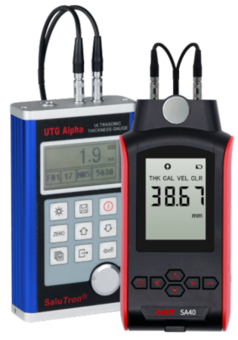
Wall Thickness Devices
for non-destructive ultrasonic wall thickness measurement
The SaluTron®Messtechnik GmbH offers portable ultrasonic wall thickness gauges for a variety of applications. Our devices enable the precise measurement of material thickness of different materials. If you need assistance with wall thickness measurement, we are happy to support you with our consultation and years of experience.
Wall Thickness Gauges utilizing ultrasonic technology
If access to a test sample is limited or one-sided and therefore a caliper cannot be used, ultrasonic wall thickness measurement provides an ideal solution. This method is applied in various areas: wall thickness gauges are used for quality control of various mass-produced products and semi-finished products, such as pipes and sheets, as well as for testing casting seams and welds.
Ultrasonic refers to frequencies above the human audible range. The testing frequency of wall thickness gauges is usually between 0.5 and 10 kHz, with occasional fluctuations in exceptional cases.
The measuring method of wall thickness gauges
The device emits a pulse that causes an interaction between the speed of sound of the material and its structure. The ultrasound is reflected back to the transducer by defects in test samples, mostly air inclusions. Thus, with the help of the wall thickness gauge, even with knowledge of the speed of sound of the material used in the sample (sound constant), the depth of the defect can be detected. The actual wall thickness can be measured by the time it takes for the speed of sound to travel to the opposite side of the wall. Test materials exposed to erosions or corrosions can also be precisely and safely inspected with a wall thickness gauge.
Some selected speeds of sound at a temperature of 20 degrees Celsius of different materials longitudinally in m/s:
Gases:
- Hydrogen: 1280
- Air: 343
- Carbon dioxide: 266
Liquids:
- Water: 1484
- Benzene: 1326
- Mercury: 1450
Solids:
- Beechwood: 3300
- Concrete: 3655 (C20/25)
- Aluminum: 6250-6350
- Iron/Steel: 5920
- Marble: 6150
- Titanium: 6100
- Diamond: 18,000
In physics, a distinction is made between longitudinal and transverse sound waves. In longitudinal waves, sound waves propagate as periodic pressure and density differences, which we perceive as sound, for example, from the air in our ear at the correct frequency. The direction of vibration of the individual elements is parallel to their direction of propagation.
Transverse waves are, for example, electromagnetic waves or waves on a string, where the vibrating elements oscillate exactly perpendicular to the direction of propagation of the wave about their rest position.
